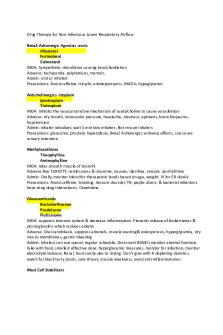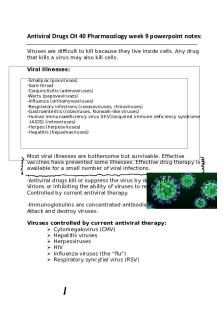Antiviral Drugs Part 1 PDF

| Title | Antiviral Drugs Part 1 |
|---|---|
| Course | Clinical Pharmacology |
| Institution | St. John's University |
| Pages | 15 |
| File Size | 443.7 KB |
| File Type | |
| Total Downloads | 24 |
| Total Views | 132 |
Summary
Dr. Chen SJU, Antiviral Drugs. Includes: Drugs to tx HIV, HSV, MoA, SE/ADR...
Description
Antiviral Drugs Human Viruses ● Cold & Flu (common) ● Stomach and Intestinal (common) ● Hepatitis (A,B,C… common in Asia) ● HSV ● HIV ● SARS-CoV-2 ● Others Cold Viruses ● Viral infxn in the lining of the nasal passages ○ Leads to… ■ Runny nose, watery eyes, scratchy throat, sneezing ○ Lasts 7-14 days ○ ~200 virus strains can cause … rhinovirus most frequently Flu Viruses ● Type A & B most common, seasonal flu (late fall-early spring) ● Type C, mild and least frequent Stomach and Intestinal Viruses ● Invade tissues of stomach and upper intestine → viral gastroeneteritis ● Rotavirus ○ Frequent gastroenteritis in infants and young children (NVD) ● Norovirus ○ Also common, affects children and adults Hepatitis ● Infects liver and causes inflammation ● Five different types of Hepatitis: ○ A, B, C, D, E ■ A: contract thru ingestion of stool contaminated food/water ; short lived eps hepatitis ■ B: acute or chronic liver infection; contract from blood or semen (needles, intercourse, other to child)
■ C: thru contact with blood (needles, mother to child) ; usually chronic infx bu tx can clear the infxn in many cases Some viruses are uncommon but very dangerous - Ebola, COVID-2, Rabies Oth common viruses - HSV (cold sores, genital herpes, shingles, chickenpox, mono) - HPV (warts, cervical cancer) - HIV (virus attacks immune cells) HIV ● If untreated can lead to AIDS ● Spread by contact with bodily fluids; most commonly thru unprotected sex or needles ● Human body can't get rid of HIV, no cure exists ○ By taking ART (antiretroviral therapy) , patients can live long healthy lives and prevent transmission of HIV ○ Effective methods to prevent getting HIV through sex/drug use include ■ PrEP (pre-exposure prophylaxis) ■ PEP (post-exposure prophylaxis) Viruses attach and enter cells… ● Once they penetrate the cell wall, they are uncoated ● They replicate and undergo protein synthesis → NA synthesis → late protein synthesis and processing ● They are packaged and assembled into the new virus ● The virus may destroys host cells and release virus out of cell to further infect cells Drugs can target different stages - Ex: Docosanol blocks viral attachment and entry in HSV
NRTIs- nucleoside reverse transcriptase inhibitors (tx HIV) NNRTIs- non-nucleoside reverse transcriptase inhibitors (tx HIV)
HSV
dsDNA viruses Broad spectrum disease, may remain latent HSV-1 = oral herpes (HHV1) HSV-2 = genitial and neonatal herpes (HHV2) Varicella virus - chickenpox and Shingles (HHV3, VSV) Cytomegalovirus - febrile illness, infectins in aids pt Lymphocryptovirus - EBV (HHV4) can cause mono, lymphomas, nasopharyngeal carcinoma ● Kaposi sarcoma - (HHV8) ● ● ● ● ● ● ●
antiHerpes drugs ● Nucleoside analogs ○ Acyclovir, penciclovir, ganciclovir ● MoA:
○ Converts to Monophosphate form via virus specific enzymes (thymidine kinase, UL97) ○ Continue to be phosphorylated to form Diphosphate and then Triphosphate ○ The Triphosphate competitively inhibits viral DNA polymerase → inhibits viral DNA synthesis ○ Triphosphate incorporates into viral DNA → Chain termination ● Structure: ○ ?? Antivirals - Herpes ● Acyclovir (Zovirax) ○ Can shorten duration of sxs, reduce viral shedding and reduce healing time of lesions ○ Take PO, topical is less effective ○ TX: ■ HSV 1, HSV 2 ■ Varicella virus - HSV 3 (chicken pox/shingles; less sensitive) ■ HSV encephalitis ■ HSV in neonates ○ MOA: ■ 1] Diffusion ■ 2] Phosphorylation ■ 3] First step requires viral thymidine kinase followed by action of host enzymes (Acyclovir → Monophosphate) ■ Acyclovir triphosphate only accumulates in infected cells. ■ 4] Inhibition of vDNApol & incorporation (chain termination) ○ SE: ■ NVD, HA, vertigo, myalgia, rash ■ *Renal failure / nephrotoxicity ■ CNS ● Tremor, seizures, delirium, neurotoxic ○ Resistance: ■ Deficient thymidine kinase activity (won't cause phosphorylation and wont work) ● Can be due to mutated form of the viral kinase
● Famciclovir (Famvir) ○ Prodrug of Penciclovir (similar to acyclovir) ○ MOA: ■ Inhibit viral DNA polymerase, but DOES NOT cause chain termination ○ SE/ADE: ■ HA, NV, Fatigue, paresthesia, pruritus ○ Higher ICF levels than acyclovir , affinity for vDNA polymerase is less than acyclovir ● Valacyclovir (Valtrex) ○ Prodrug of Acyclovir ● Ganciclovir ○ MOA: ■ Inhibits vDNA polymerase, no chain termination ■ Activated phosphorylation (guanosine analog) ○ TX: ■ HSV-CMV (causes mono or more severe infxn) ■ VZV ■ EBV ○ SE/ADE: ■ Suppression of the BONE MARROW ● Leukopenia, thrombocytopenia, anemia ■ Others (rare) ● HA, Seizures, Tremor, Hypersensitivity ○ Enters CSF, poor bioavailability Cidofovir ● MOA: ○ Conversed by host kinase to cidofovir diphosphate ○ Similar to acyclovir; inhibit viral DNA polymerase and stop viral DNA synthesis ○ False nucleotide interrupts DNA synthesis ● TX: ○ CMV (type 5) ○ Retinitis ● SE/ADE: ○ Nephrotoxic ● Long half life, slow elimination = give once/week
Foscarnet ● MOA: ○ Inhibits vDNApol, RNApol & RT ○ DOES NOT require phosphorylation ● TX: ○ Severe herpes virus resistant to firstline therapy ● IV administration, poor bioavailability ● Small molecule, easily cross cell membrane ● SE/ADE: ○ Renal, nephrotoxic ○ Ca++ & K+ alterations ○ CNS side effx ■ Seizure ■ Hallucinations ○ HA ○ Physical characteristics - *Corrosive Idoxuridine ● Topical tx for herpes ○ Too toxic for systemic administration ● Pyrimidine analog Sorviudine ● Oral ● Pyrimidine analog ; activated by thymidine kinase Trifluridine ● Topical- HSV , opthalmic ● Inhibit vDNA synthesis ● Fluorinated pyrimidine Vidarabine ● Topical ointment for HSV and VZV ● Infusion for HSV encephalitis ● Adenosine analog ● Phosphorylated to ara-ATP
Drug Targets for HIV ● Fusion Inhibitors ● RT Inhibitors
● Integrase Inhibitors ● Protease Inhibitors ○ Prevent new immature HIV from becoming mature and infecting other cells Drug Classes Used to Tx HIV 1. 2. 3. 4. 5. 6. 7.
Non-nucleoside reverse transcriptase inhibitors (NNRTIs) Nucleoside reverse transcriptase inhibitors (NRTIs) Protease inhibitors (PIs) Fusion inhibitors. CCR5 antagonists. Integrase strand transfer inhibitors (INSTIs) Post-attachment inhibitors.
Reverse Transcriptase Inhibitors ● NRTIs & NNRTIs ● MOA: ○ Block the conversion of HIV RNA to HIV DNA NRTIs ● Zidovudine (Retrovir)* ○ First FDA approved ○ MOA: ■ Inhibits in vitro replication of some retroviruses, cellular thymidine kinase phosphorylates. ■ Zidovudine triphosphate interferes with HIV vRNA-dependent DNA polymerase (RT) ■ Incorporated into DNA chain, terminated synthesis ○ TX: ■ Initial tx of HIV infected adults ○ SE/ADE: ■ NVD ■ Bone marrow suppression ● Anemia, neutropenia ■ GI ■ HA ■ Peripheral neuropathy ○ Resistance: ■ In vitro resistance - accumulation of specific mutation in HIV RT
● Didanosine * ○ Second FDA approved ○ MOA: ■ ddATP, competitive inhibition - RT & chain termination ○ SE/ADE: ■ Dose-dependent pancreatitis ■ Diarrhea ■ Hepatotoxicity ■ CNS (HA, irritability) ■ Incr Uric acid ■ Peripheral neuropathy ○ Resistance can occur ● Stavudine * ○ Forms triphosphate and integrate into viral DNA; inhibit RT and chain termination ● Lamivudine * ○ This one can be usful in Hep B tx ○ TX HIV ● Abacavir * ○ Drug is hydrolyzed to carbovir , converted to active metabolite triphosphate form ■ Inhibits HIV RT , competes with dGTP and incorporates in viral DNA ■ Viral DNA growth is terminated ○ Can be combined with drugs for synergistic antiviral activity ○ SE/ADE: ■ *Hypersensitivity ● Emtricitabine ● Entecavir ● Apricitabine NtRIs (Nucleotide Reverse - Transcriptase Inhibitors) ● Tenofovir ○ Poorly penetrate cells, not absorbed when given PO ○ Internalized into cells by endocytosis, and phosphorylated to active metabolite → tenofovir diphosphate ○ MOA:
■ Similar to NRTIs; tenofovir diphosphate competes with deoxyadenosine triphosphate for incorporation into newly formed HIV DNA → chain termination ○ SE/ADE: ■ Nausea ■ Dizzy ■ Loss of appetite ■ Loose stool ● Tenofovir Disoproxil (TDF , Viread) ○ Prodrug version of tenofovir ○ Version of drug that can be taken PO, enhanced oral absorption …. Better bioavailability ( we prefer nucleobase, nucleoside (ribose) over drug that’s nucleotide (ribose and phosphate grp, bigger and charged… harder to get into cell and cross membrane…) NNRTIs ● Nevirapine* (Viramune®); Delavirdine* (Rescriptor®); Efavirenz* (Sustiva®); Etravirine (Intelence®), Rilpivirine (Edurant®); Loviride* ● TX: ○ HIV-1 , HIV-2 ● MOA: ○ Inhibit viral reverse transcriptase (RT), although mechanism differs from NRTI. ○ Inhibit HIV-1 RT. Preventing incorporation of vRNA into the host and subsequent replication of HIV ● SE/ADE: ○ Allergy/hypersensitivity ○ Rash, cutaneous rxn ○ Somnolence ○ Fatigue ○ Sedation ○ Hepatoxicity ○ Drug induced fever ● Nevirapine ○ First licensed ○ More safety data in pregnant women
Protease Inhibitors ● MOA: ○ Block protease → prevent new (immature) HIV from becoming a mature virus that can infect other CD4 cells ○ Prevent viral protease enzyme from cleaving the polyprotein precursor to viral coat protein and reduces activation of critical viral proteins/enzymes. Thus, new virions are formed, but are defective and cannot infect other cells ● Saquinavir (Invirase®) Lopinavir, Ritonavir (Norvir®), Fosamprenavir, Indinavir (Crixivan®) Atazanavir, Nelfinavir (Viracept®), Tipranavir, Amprenavir, Darunavir ● TX: ○ HIV ● SE: ○ NVD, allergy hypersensitivity, rash, hypotension, CNS, paresthesias, fever, sweating, altered, anorexia, hyperbilirubinemia
INSTIs (Integrase strand transfer inhibitors) ● MOA: ○ Block integrase. HIV uses integrase to add vDNA into host DNA in CD4 cells. Blocking integrase prevents HIV from replicating ● Raltegravir (Isentress), Dolutegravir, Elviegravir ● ADR/SE: N,V, flatuence, LFT's, amylase, headache, dizziness, abnormal dreams, rash/pruritis, fatigue, imsomnia, muscle pain, altered WBC count CCR5 Antagonists ● Maraviroc (Selzentry) ● MOA: ○ CCR5 antagonists block the CCR5 coreceptor on surface of immune cells, such as CD4 T lymphocytes (CD4 cells). ■ Preventing HIV from entering the cell ● ADR/SE: N,D; LFT's, hepatitis, Respiratory tract infections, dizziness, headache, joint pain, muscle pain, cough
Fusion Inhibitor ● Enfuvirtide (Fuzeon) ● MOA:
○ A fusion inhibitor blocks the HIV envelope merging with host CD4 cell membrane. Preventing HIV from entering the CD4 cell ● SE/ADE: ○ Pain, tingling, PNA, allergic rxn...
Similar Free PDFs

Antiviral Drugs Part 1
- 15 Pages

Antiviral pharm
- 13 Pages

Exam 1- Cardiac Drugs
- 11 Pages

CPT 1- Drugs
- 3 Pages

Drugs for Most 1
- 9 Pages

Herpes drugs, anti cancer drugs
- 6 Pages

Hemostasis drugs
- 5 Pages

Psychotomimetic drugs
- 7 Pages

Controlled Drugs
- 25 Pages

Part 1
- 2 Pages

Respirotory Drugs
- 3 Pages

Dopaminergic Drugs
- 2 Pages
Popular Institutions
- Tinajero National High School - Annex
- Politeknik Caltex Riau
- Yokohama City University
- SGT University
- University of Al-Qadisiyah
- Divine Word College of Vigan
- Techniek College Rotterdam
- Universidade de Santiago
- Universiti Teknologi MARA Cawangan Johor Kampus Pasir Gudang
- Poltekkes Kemenkes Yogyakarta
- Baguio City National High School
- Colegio san marcos
- preparatoria uno
- Centro de Bachillerato Tecnológico Industrial y de Servicios No. 107
- Dalian Maritime University
- Quang Trung Secondary School
- Colegio Tecnológico en Informática
- Corporación Regional de Educación Superior
- Grupo CEDVA
- Dar Al Uloom University
- Centro de Estudios Preuniversitarios de la Universidad Nacional de Ingeniería
- 上智大学
- Aakash International School, Nuna Majara
- San Felipe Neri Catholic School
- Kang Chiao International School - New Taipei City
- Misamis Occidental National High School
- Institución Educativa Escuela Normal Juan Ladrilleros
- Kolehiyo ng Pantukan
- Batanes State College
- Instituto Continental
- Sekolah Menengah Kejuruan Kesehatan Kaltara (Tarakan)
- Colegio de La Inmaculada Concepcion - Cebu



